7 Best Asset Classes to Hedge Against Inflation
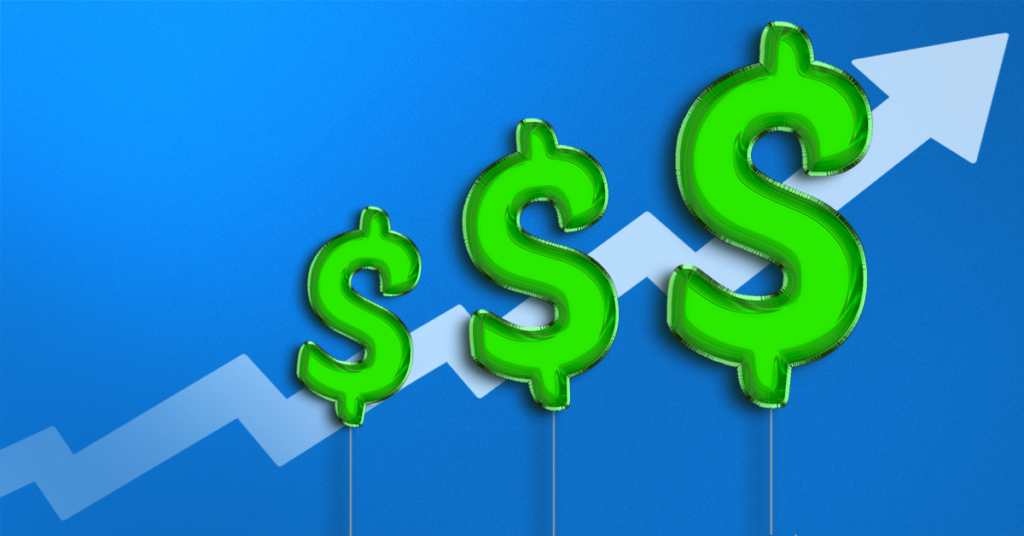
As investors continue to lament recession worries and market volatility, the US Inflation Rate has cooled to 3.36% in April 2024, a significant improvement from its alarming 9.06% mark in June 2022. Perhaps the Fed’s eleven consecutive rate hikes since March 2022 are serving their intended purpose of easing inflation from levels not seen since the 1980s?
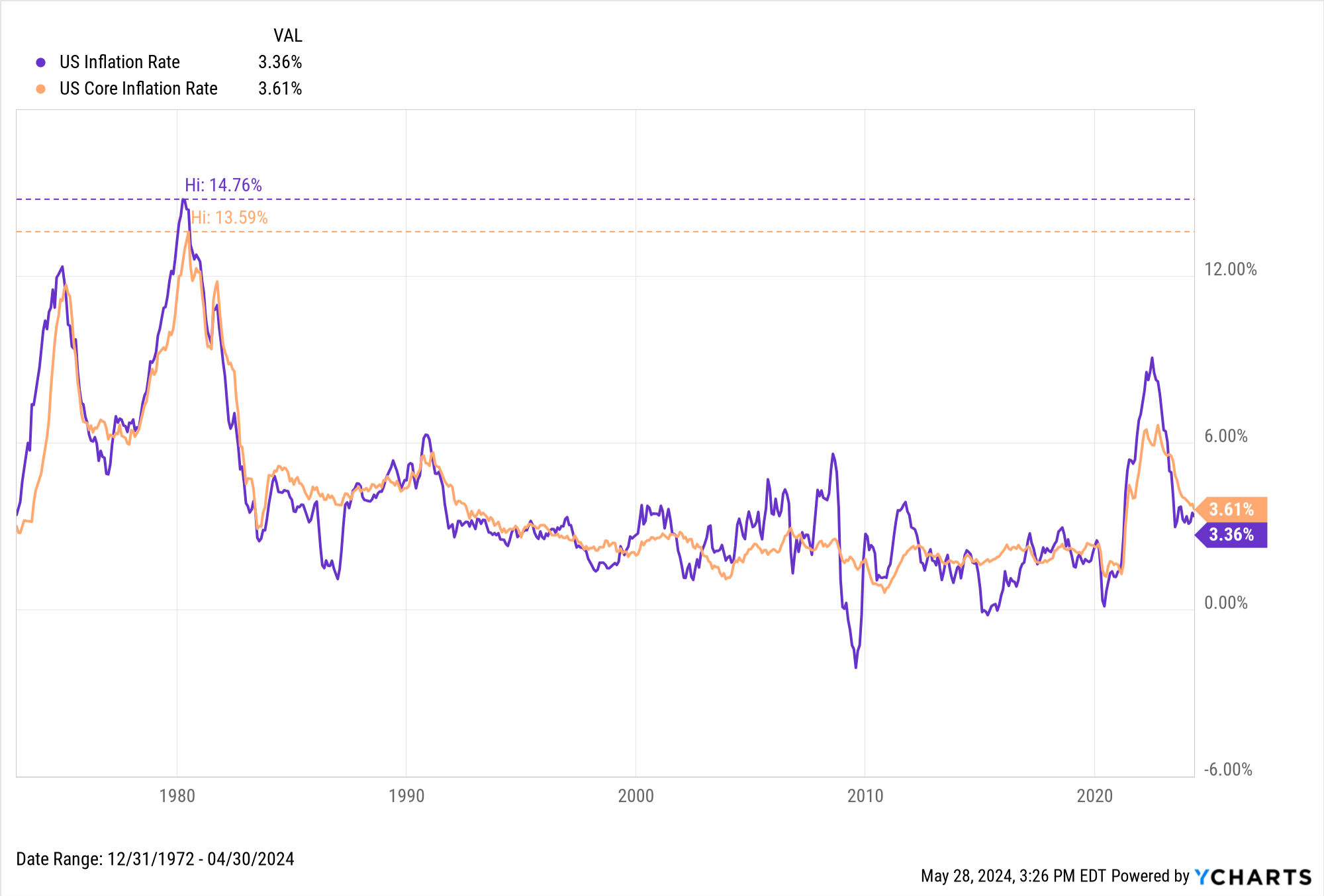
Download Visual | Modify in YCharts
Inflation is a rise in an economy’s overall average price level and a decline in the purchasing power of that economy’s domestic currency. Core Inflation measures changes in the overall price level minus food and energy costs.
It’s important to note that inflation affects more than just the price of consumer goods, as measured by the Consumer Price Index. Nearly every asset class can take a hit from inflation in one way or another. While rising prices can be a sign of economic growth, translating into higher corporate earnings and elevated stock prices, it is a double-edged sword. Historically, rapid inflation prompts central banks to hike interest rates to control runaway prices. Bond yields rise, causing prices to fall, future corporate earnings are discounted further while equities sell off, and any adjustable rate credit product becomes more expensive.
If the thought of inflation makes you queasy—and switching to day-old milk is not your idea of coping with inflation—then you’re in the right place.
Here are seven of the best ways to hedge your portfolio against inflation:
• Commodities (including Gold and Precious Metals)
1. Ex-US ETFs and Mutual Funds
Inflation is typically regarded as a negative for stocks, as it increases companies’ borrowing and production costs, further discounts future earnings, and ultimately leads to lower expected earnings growth. If the earnings of US companies are expected to shrink, investments that exclude domestic companies (i.e Ex-US funds) can hedge a predominantly US portfolio and capture potential returns from worldwide markets where inflation may not be as high.
Examples of ex-US ETFs:
- Vanguard FTSE All-World ex-US ETF (VEU)
- SPDR Portfolio Developed World ex-US ETF (SPDW)
- iShares MSCI ACWI ex US ETF (ACWX)
- iShares MSCI ACWI ex-US ETF (CWI)
Examples of ex-US Mutual Funds:
- Fidelity Global ex US Index (FSGGX)
- Vanguard FTSE All-World ex-US Index Admiral (VFWAX)
- State Street Global All Cap Equity ex-US Index (SSGVX)
According to the theory of diversification, the less correlated two investments are, the more they can protect investors from downside risk. Expanding the variety of investments in a portfolio can potentially limit its overall volatility. While diversification is typically approached in terms of asset classes, it also applies geographically. In this case, increasing exposure outside of the US could reduce home country bias and make for an effective hedge against domestic inflation.
2. “Defensive” Stocks
Though rising inflation has historically led to Fed rate hikes, which can stymie stock market returns, certain sectors act as a counter to higher inflation since they tend to appreciate in times such as these. Materials, Consumer Staples, and Utilities are examples of lower-volatility sectors that defensive investors often rotate into. When both inflation and the prices of raw materials rise, Materials stocks have followed upward.
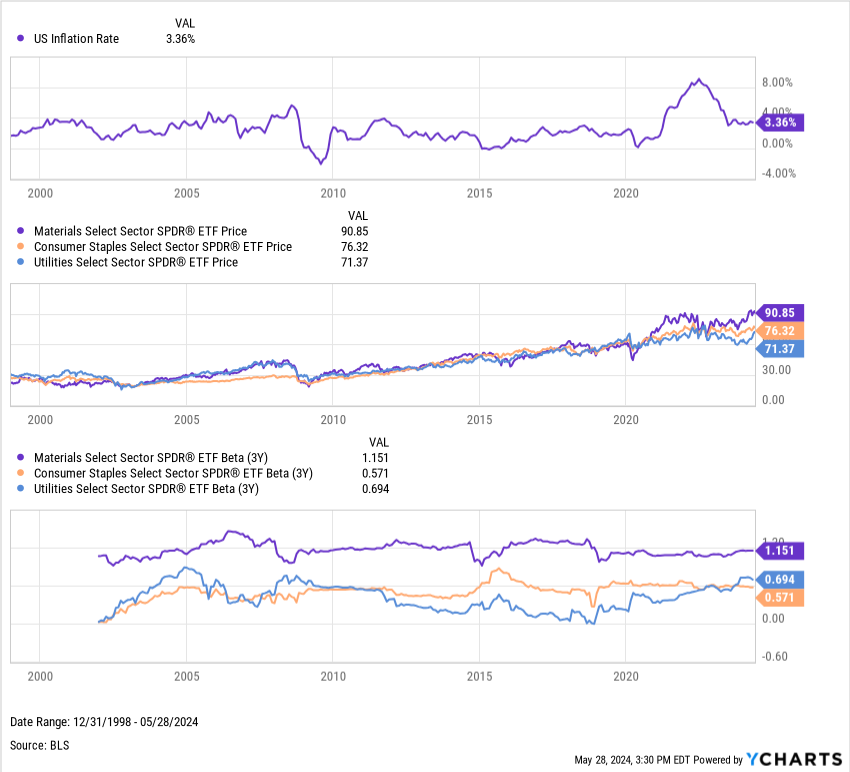
Download Visual | Modify in YCharts
As for Consumer Staples, many of the companies in that sector are considered “recession-proof”. Think household products, personal care items, and groceries—no matter if inflation is 1% or 10%, everyone will need to eat, do the dishes, and brush their teeth, right? Therefore, consumer staple companies are favored by investors seeking protection from inflation, since they are thought to deliver consistent earnings with lower volatility no matter the current economic environment.
Finally, the merits of the Utilities sector in an inflationary environment include the average stock in that sector sporting the third-highest dividend and lowest beta of the eleven sectors. Utility stocks are often viewed as a sort of bond hybrid, sporting the risk-off elements of fixed income instruments with the ability to generate current income via dividends. And, similar to Consumer Staples, many Utilities companies are considered recession-proof as people depend on powering and heating their homes.
3. Bonds, including TIPS
The Fed’s Open Market Committee (FOMC) hikes the Fed Funds rate as a means to control inflation, leading to higher interest rates across all fixed income durations.
During inflationary periods, investors might consider expanding their fixed income positions, as higher risk-free returns make bonds more attractive compared to risky assets such as equities.
But be aware: timing is everything. Purchasing bonds after markets have priced in a rate hike is one thing, but buying them before a rate hike occurs might lead to depreciated values of those bonds.
Treasury yields are typically one of the biggest beneficiaries during rate hikes, as seen most recently in 2016 and now in 2024.
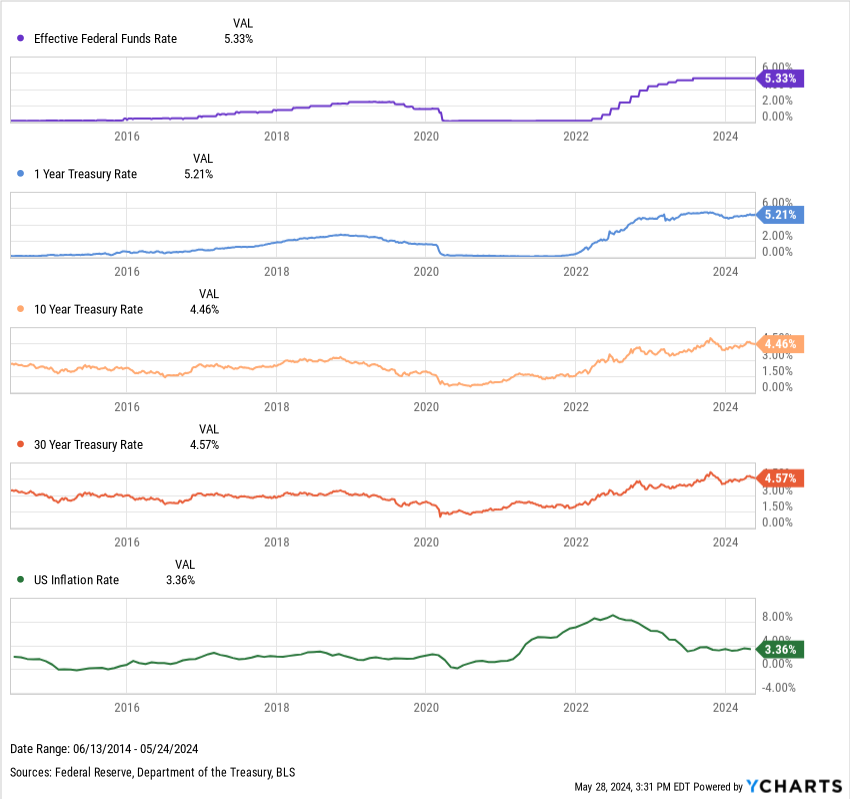
Download Visual | Modify in YCharts
Treasury Inflation Protected Securities (TIPS) are fixed-income instruments similar to treasury bonds, but they’re specifically designed to protect against inflation. Just as treasuries fluctuate based on interest rates, TIPS principal values appreciate when inflation rises. During inflationary periods, TIPS can provide added returns and protection to a portfolio if or when equity prices dive. TIPS are available in 5, 10, and 30-year durations.
4. Foreign Currencies
Inflation not only decreases a currency’s purchasing power domestically. It can also weaken a currency compared to other countries’ tenders. A weaker exchange rate can stimulate activity from foreign buyers. For example, as recently as 2022, the US dollar and Euro were at parity for the first time in 20 years, making that long-awaited trip overseas less expensive.
On the flip side, holders of the weakened currency are at a disadvantage when purchasing from foreign nations. For instance, the US dollar experienced relative weakness against the Pound, Canadian Dollar, Euro, and Australian Dollar from March 2020 through the first half of 2021, partially due to rising inflation. But as inflation hit the rest of the world in 2022, the US Dollar strengthened once again.
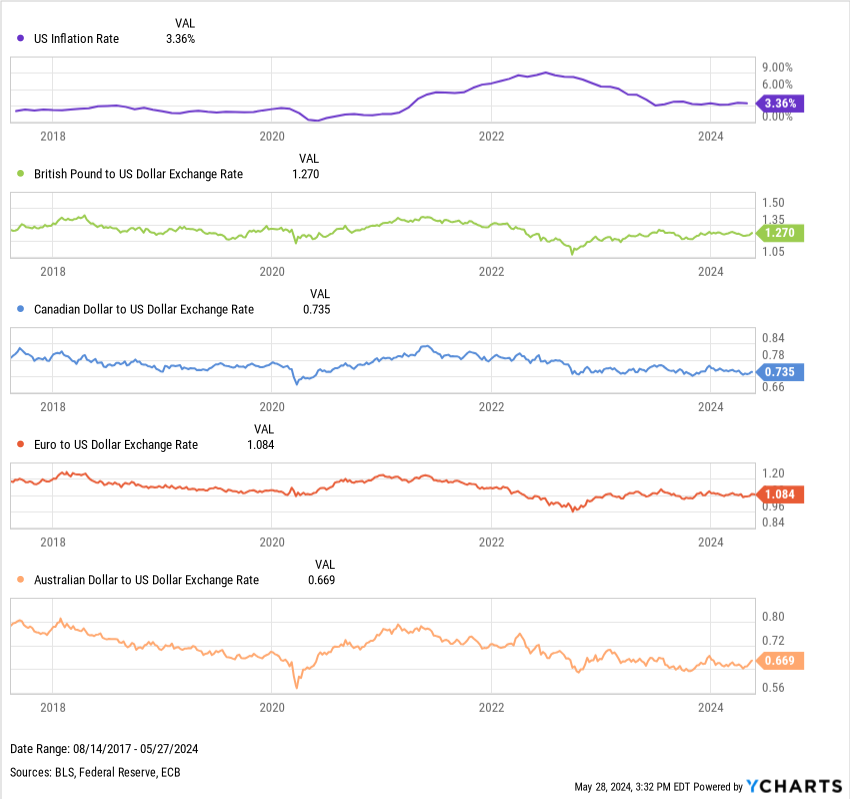
Download Visual | Modify in YCharts
The Japanese Yen has often been regarded as a safe haven for US dollar holders in times of economic uncertainty. Japan’s historically steady economic growth and inflation rate have resulted in tame exchange rate fluctuations, providing a hedge against the inflation-induced devaluation of the US dollar.
However, even Japan has felt the effects of rising inflation. Japan inflation reached 4.3% in January 2023 and remains well above its long-term average. Since January 2022, the US Dollar has appreciated 35% against the Yen.
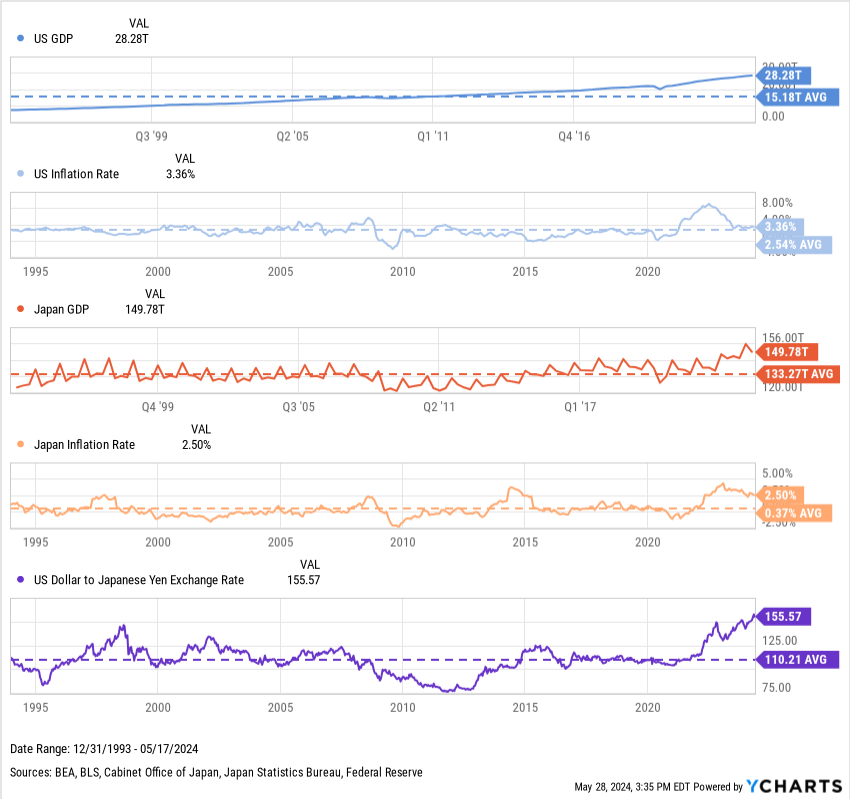
Download Visual | Modify in YCharts
5. Gold, Precious Metals, and Commodities
All that glitters is gold, especially during times of inflation.
Precious metals such as gold have been historical favorites for hedging against inflation due to their scarcity, tangibility, and historically negative correlation to paper money.
Since 1979, the purchasing power of the US Dollar has declined by 78%. Meanwhile, the price of gold per ounce has risen more than 937% and continues to set all-time highs as inflation remains at or above its long-term average level.
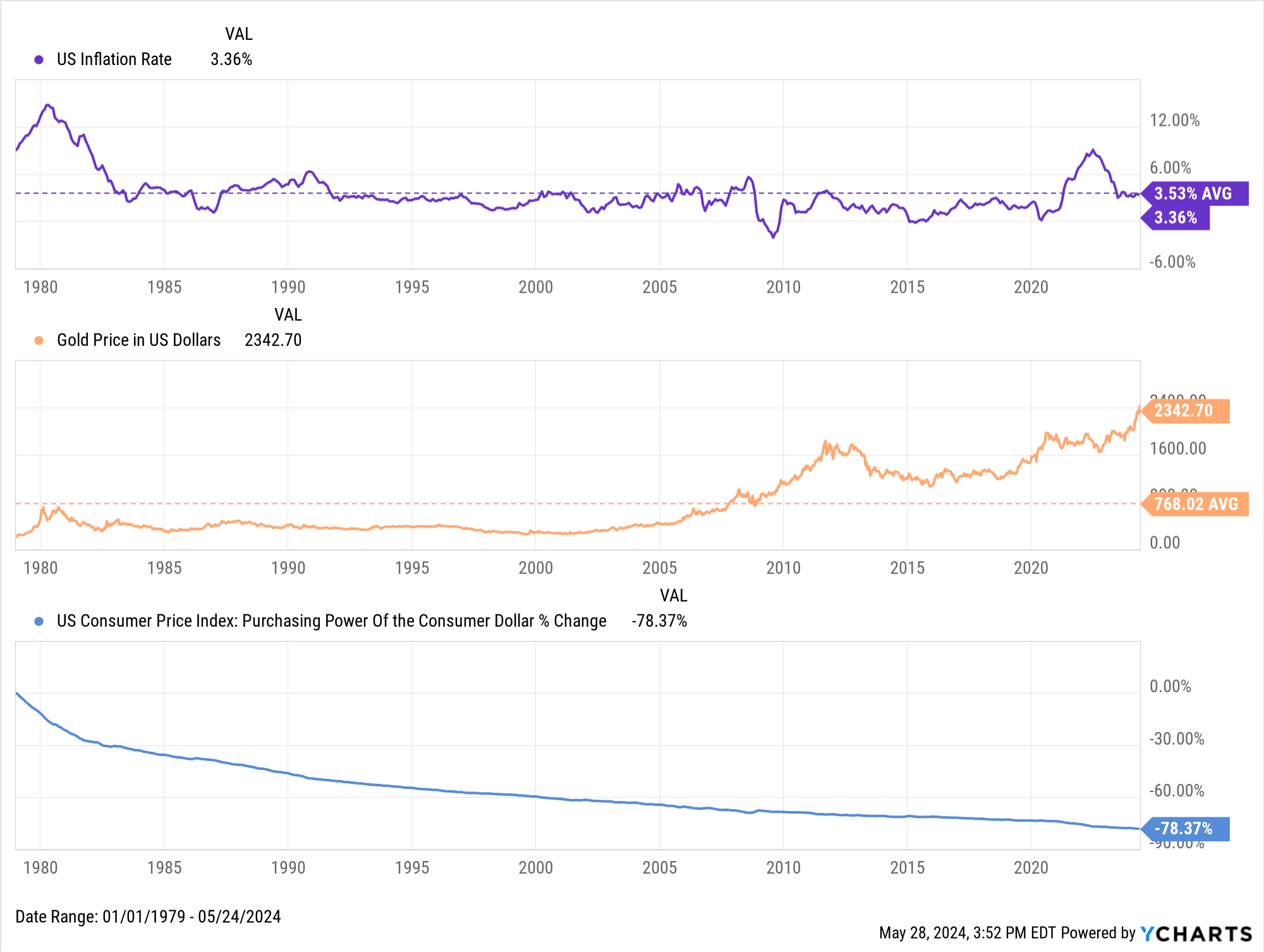
Download Visual | Modify in YCharts
In addition to owning physical gold, investors can consider adding gold miners, ETFs, or even currency-hedged gold funds to their portfolios to “stay golden” through inflation. Some of these plays include:
- SPDR Gold Shares (GLD)
- iShares Gold Trust (IAU)
- VanEck Vectors Gold Miners ETF (GDX)
- Aberdeen Standard Gold ETF (SGOL)
Other tangible assets include commodities, such as oil, lumber, and steel, whose prices not only increase with inflation but also act as indicators of both future inflation and economic growth. As the economy expands, the demand for commodities heats up, pushing their prices higher.

Download Visual | Modify in YCharts
6. Real Estate
Like precious metals, real estate is a tangible asset that tends to hold value during prevalent inflation. As prices rise, so do property values and rents, increasing the amount of rental income earned along with the book value of property.

Download Visual | Modify in YCharts
Existing homeowners may actually welcome inflation as it translates to more valuable equity. As seen in the chart above, the US Existing Home Median Sales Price saw a surge in prices as inflation rose in 2022, which has sustained around $400,000 even as inflation returned to the 3.0 to 3.5% range. Real estate taxes could also increase in kind, however. If you’re considering buying a home for the first time, elevated home prices might have you second-guessing that corner lot in the ‘burbs.
Alternatively, the benefits of owning actual real estate can be captured by adding Real Estate Investment Trust (REIT) holdings to a portfolio. REITs typically operate conglomerates of real estate and are investor-owned. Those investors receive distributions on the REIT’s rental income, interest, and property sales. There are hundreds of REIT equities, ETFs, and Mutual Funds in the YCharts database, in addition to general real estate sector securities such as the SPDR Select Real Estate Sector ETF (XLRE).
7. Cryptocurrencies
Those who wish to diversify out of fiat currencies entirely might seek alternative stores of value. One emerging asset class, cryptocurrency, includes digital assets like Bitcoin, Ethereum, and Cardano. While a tumultuous 2022 has prompted some to question the reliability of cryptocurrencies as inflation hedges, all-time highs in early 2024 showcased the emerging concept of decentralized monetary value storage along with a price rebound that helped crypto regain popularity.
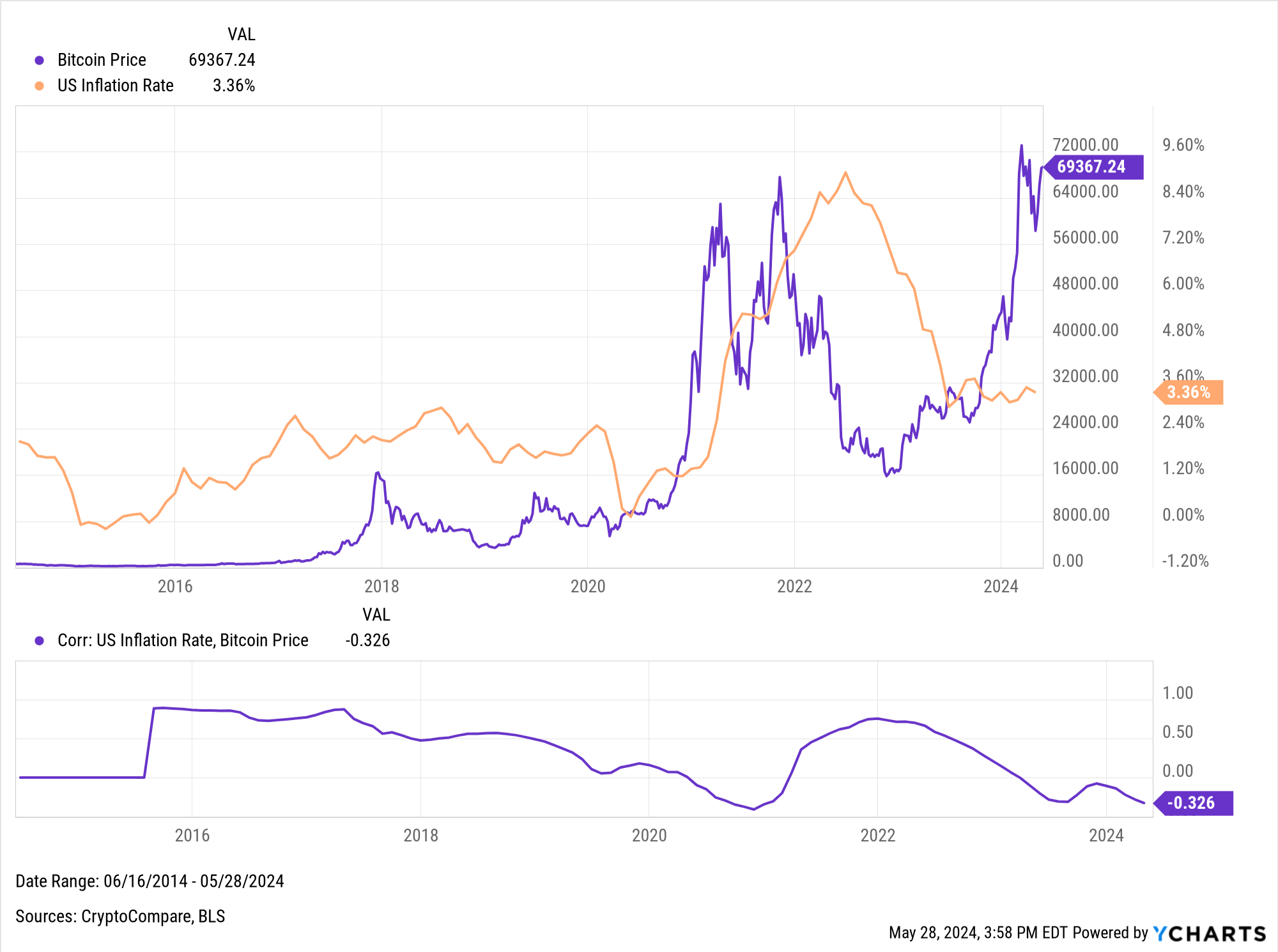
Download Visual | Modify in YCharts
US investors can join the crypto craze by owning coins directly or buying shares in crypto trusts or ETFs. Some of the ones available on YCharts include:
- Grayscale Bitcoin Trust (GBTC)
- Grayscale Ethereum Trust (ETHE)
- Grayscale ZCash Trust (ZCSH)
- ProShares Bitcoin Strategy ETF (BITO)
- Bitwise Crypto Industry Innovators ETF (BITQ)
- iShares Bitcoin Trust ETF (IBIT)
- Fidelity Wise Origin Bitcoin ETF (FBTC)
- Bitwise Bitcoin ETF (BITB)
- Osprey Bitcoin Trust (OBTC)
- Invesco Galaxy Bitcoin ETF (BTCO)
- Valkyrie Bitcoin ETF (BRRR)
- ARK 21Shares Bitcoin ETF (ARKB)
The Bottom Line
Whether it’s at the grocery store or out on the road, consumer demand and healthy economic activity (or sometimes money printing and resource scarcity) ignite inflation and send prices higher. Though consumers and investors alike have valid reasons for concern, there are many ways to protect long-term investments against the threats of inflation. From ex-US investing to snapping up gold and property, the number of available options to hedge your portfolio against inflation should keep you sleeping well at night.
Whenever you’re ready, there are 3 ways YCharts can help you:
1. Interested in visually illustrating the effects of inflation on client portfolios?
Send us an email at hello@ycharts.com or call (866) 965-7552. You’ll be directly in touch with one of our Chicago-based team members.
2. Want to test out YCharts for free?
Start a no-risk 7-Day Free Trial.
3. Download our Top 10 Visuals slide deck for more illustrative visuals about inflation:
Disclaimer
©2024 YCharts, Inc. All Rights Reserved. YCharts, Inc. (“YCharts”) is not registered with the U.S. Securities and Exchange Commission (or with the securities regulatory authority or body of any state or any other jurisdiction) as an investment adviser, broker-dealer, or in any other capacity, and does not purport to provide investment advice or make investment recommendations. This report has been generated through application of the analytical tools and data provided through ycharts.com and is intended solely to assist you or your investment or other adviser(s) in conducting investment research. You should not construe this report as an offer to buy or sell, as a solicitation of an offer to buy or sell, or as a recommendation to buy, sell, hold or trade, any security or other financial instrument. For further information regarding your use of this report, please go to: ycharts.com/about/disclosure
Next Article
A Closer Look at April 2024 Fund Flows: Defined Outcome and Fixed Income ETFs Take Center StageRead More →
